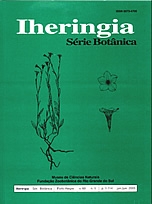Floristic study of the Asteraceae family in the “Casa de Pedra” site and adjacent areas, Bagé, Rio Grande do Sul, Brazil
Keywords:
Asteraceae, Rio Grande do Sul State, Brazil, Flora.Abstract
The Asteraceae family is cosmopolitan, but it is better represented in temperate and subtropical regions around the world. There is a large number of species in Rio Grande do Sul, mainly in grassland regions. The “Casa de Pedra” region, located in the Bagé municipality, is characterized for its rocky formations which stand out on its wavy landscape. The floristic composition of this site was surveyed by collecting representatives of this family that were blooming in all environments during different times of the year. The total numbers recorded were 87 species of 47 genera distributed within 12 tribes. Most of them are herbs (47) and sub-shrubs (28). The greater number of species were found on the sides road, on fields with rocky outcrops, and on
grazed fields, with 47, 30, and 25 species respectively. A greater number of blooming specimens was found during springtime and summertime, Heterothalamus allienus Kuntze and Baccharis and Senecio species stood out. Two locally situated species, Mikania capricorni B.L. Rob. and M. variifolia Hieron., are cited as threatened species on the endangered species list of plants in Rio Grande do Sul state. The large number of Asteraceae found confirms the importance of this family in the state.
Downloads
References
BREMER, K. 1994. Asteraceae, cladistics & classification. Portland: Timber Press. 752 p.
CABRERA, A. L.; KLEIN, R. M. 1989. Compostas (Eupatorieae). Flora Ilustrada Catarinense, Comp., Itajaí. p.649-750.
CABRERA, A. L. et al. 2000. Catálogo Ilustrado de las Compuestas (= Asteraceae) de la Província de Buenos Aires, Argentina: sistemática, ecología y usos. La Plata: Secretaria de Politica Ambiental. 136p.
FERNANDES, I.; BAPTISTA, L. R. M. 1999. Inventário da flora vascular rupestre e para-rupestre de “Casa de Pedra”, Bagé, Rio Grande do Sul. Pesquisas. Botânica, São Leopoldo, n. 49, p. 53-70.
GIRARDI-DEIRO, A. M.; GONÇALVES, J. O. N.; GONZAGA, S. S. 1992. Campos naturais ocorrentes nos diferentes tipos de solo no município de Bagé, RS. 2: fisionomia e composição florística. Iheríngia, série Botânica, Porto Alegre, n. 42, p. 55-79.
MATZENBACHER, N. I. 1985. Levantamento florístico preliminar das Compostas da fazenda São Maximiano, Guaíba, Rio Grande do Sul, Brasil. Comunicações do Museu de Ciências da PUCRS, série Botânica, Porto Alegre, v. 37, p. 115-127.
______. 1998. O complexo “Senecionóide” (Asteraceae- Senecioneae) no Rio Grande do Sul, Brasil. 274f. Tese (Doutorado em Ciências) – Programa de Pós-Graduação em Botânica, Universidade Federal do Rio Grande do Sul, Porto Alegre.
MONDIN, C. A. 1996. A tribo Mutisieae Cass. (Asteraceae), sensu Cabrera, no Rio Grande do Sul e suas relações biogeográficas. 166f. Dissertação (Mestrado em Botânica) – Programa de Pós-Graduação em Botânica, Universidade Federal do Rio Grande do Sul, Porto Alegre.
MONDIN, C. A.; BAPTISTA, L. R. M. 1996. Relações biogeográficas da tribo Mutisieae Cass. (Asteraceae), sensu Cabrera, no Rio Grande do Sul. Comunicações do Museu de Ciências da PUCRS, série Botânica, Porto Alegre, v. 2, n. 1, p. 49-152.
MUELLER-DOMBOIS, D.; ELLENBERG, H. 1974. Aims and Methods of Vegetation Ecology. New York: Wiley, 547 p.
NAKAJIMA, J. N. 2000. A família Asteraceae no Parque Nacional da Serra da Canastra, Minas Gerais, Brasil. 467f. Tese (Doutorado em Botânica). Instituto de Biologia, Universidade Estadual de Campinas, Campinas.
RAMBO, B. 1952. Análise geográfica das compostas sul-brasileiras. Anais Botânicos do Herbário Barbosa Rodrigues, Itajaí, v. 4, p. 87-160.
______. 1956. A fisionomia do Rio Grande do Sul. Porto Alegre: Livraria Selbach. 471p.
______. 1960. Die europäischen Unkräuter in Südbrasilien. Sellowia, Itajaí, v. 12, p. 45-78.
RIO GRANDE DO SUL 2003. Decreto n° 42.099 de 31 de dezembro de 2002. Declara as espécies da flora nativa ameaçadas de extinção no Estado do Rio Grande do Sul e dá outras providências. Diário Oficial Estado do Rio Grande do Sul, Porto Alegre, v. 42, n. 1.
RITTER, M. R. 2002. Taxonomia e biogeografia do gênero Mikania Willd. (Asteraceae-Eupatorieae) no Rio Grande do Sul, Brasil. 335f. Tese (Doutorado em Ciências) – Programa de Pós-Graduação em Botânica, Universidade Federal do Rio Grande do Sul, Porto Alegre.







